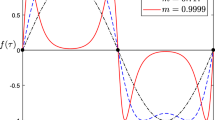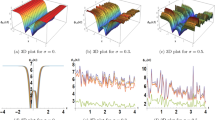Abstract
The phenomenon of relaxation oscillations is a typical fast–slow dynamical behavior. In this paper, we take a type of nonlinear oscillator involving multiple coexisting attractors as an example and aim to reveal interesting patterns of relaxation oscillations, namely the so-called compound relaxation oscillations. To begin with, a relaxation oscillation pattern with asymmetrical transitions is obtained. Then, a two-parameter bifurcation diagram is plotted to explore the transitions of relaxation oscillations. It is found that the number and stability of the attractors near fold bifurcation points may change when the system parameters vary. This is manifested in two ways: First, when a fold bifurcation occurs in the upper equilibrium branch, the system is bi-stable; while a fold bifurcation occurs in the lower equilibrium branch, the system is stable. Second, the system is bi-stable when fold bifurcations occur in the upper and lower equilibrium branches. For the above two cases, we use fast–slow analysis and attraction domain analysis to explore the dynamical mechanisms of the relaxation oscillation behaviors. As a result, several different relaxation oscillation patterns are obtained. In particular, relaxation oscillations with asymmetric structure, i.e., compound relaxation oscillations, characterized by the system trajectory transitions passing through the middle branch at one end and crossing it at the other, are discovered and researched.









Similar content being viewed by others
Data availability
The data used to support the finding of this study are available from the corresponding author upon reasonable request.
References
Chatterjee, S., Singha, T.K., Karmakar, S.K.: Non-trivial effect of fast vibration on the dynamics of a class of non-linearly damped mechanical systems. J. Sound Vib. 260, 711–730 (2003)
Gomez-Uribe, C.A., Verghese, G.C., Tzafriri, A.R.: Enhanced identification and exploitation of time scales for model reduction in stochastic chemical kinetics. J. Chem. Phys. 129, 244112 (2008)
Wang, J., Liu, S.Q., Liu, X.L., Zeng, Y.J.: Bifurcation and firing patterns of the pancreatic beta-cell. Int. J. Bifurc. Chaos 25, 1530024 (2015)
Qian, Y.H., Yan, D.M.: Fast-slow dynamics analysis of a coupled duffing system with periodic excitation. Int. J Bifurc. Chaos 28, 1850148 (2018)
Shilnikov, A.L., Rulkov, N.F.: Origin of chaos in a two-dimensional map modeling spiking-bursting neural activity. Int. J. Bifurc. Chaos 13, 3325–3340 (2003)
Yang, Z.Q., Lu, Q.S.: Different types of bursting in chay neuronal model. Sci. China Ser. G Phys. Mech. Astron. 51, 687–698 (2008)
Nyman, K.H.M., Ashwin, P., Ditlevsen, P.D.: Bifurcation of critical sets and relaxation oscillations in singular fast-slow systems. Nonlinearity 33, 2853–2904 (2020)
Debnath, S., Sahoo, S.R., Decardi-Nelson, B., Liu, J.F.: Subsystem decomposition and distributed state estimation of nonlinear processes with implicit time-scale multiplicity. AIChE J. 68, e17661 (2022)
Shi, M., Wang, Z.H.: Abundant bursting patterns of a fractional-order morris-lecar neuron model. Commun. Nonlinear Sci. Numer. Simul. 19, 1956–1969 (2014)
Marino, F., Marin, F.: Coexisting attractors and chaotic canard explosions in a slow-fast optomechanical system. Phys. Rev. E 87, 052906 (2013)
Perc, M., Marhl, M.: Different types of bursting calcium oscillations in non-excitable cells. Chaos Solitons Fractals 18, 759–773 (2003)
Li, Z.J., Li, Y., Ma, M.L., Wang, M.J.: Delayed transcritical bifurcation induced mixed bursting in a modified Sm system with asymmetrically distributed equilibria. Braz. J. Phys. 51, 840–849 (2021)
Han, R.J., Dai, B.X.: Spatiotemporal dynamics and spatial pattern in a diffusive intraguild predation model with delay effect. Appl. Math. Comput. 312, 177–201 (2017)
Edmunds, J.L.: Multiple attractors in a discrete competition model. Theor. Popul. Biol. 72, 379–388 (2007)
Yu, J.L., Dai, X., Chen, W.S., Wang, C.X., Qi, J.: Coexistence of multiple continuous attractors for lower-ordered neural networks. Int. J. Comput. Math. 97, 2462–2473 (2020)
Lai, Q., Xu, G.H., Pei, H.Q.: Analysis and control of multiple attractors in sprott B system. Chaos Solitons Fractals 123, 192–200 (2019)
Zhu, L., Pan, M.H.: Coexisting multiple attractors in a fourth order chua’s circuit with experimental verifications by analog and digital circuits. IEEE Access 9, 96671–96681 (2021)
Kroetz, T., Portela, J.S.E., Viana, R.L.: Coexistence of subharmonic resonant modes obeying a period-adding rule. Int. J. Bifurc. Chaos 28, 1830031 (2018)
Guckenheimer, J., Hoffman, K., Weckesser, W.: The forced van der pol equation I: the slow flow and its bifurcations. SIAM J. Appl. Dyn. Syst. 2, 1–35 (2003)
Bold, K., Edwards, C., Guckenheimer, J., Guharay, S., Hoffman, K., Hubbard, J., Oliva, R., Weckesser, W.: The forced van der pol equation II: canards in the reduced system. SIAM J. Appl. Dyn. Syst. 2, 570–608 (2003)
Han, X.J., Bi, Q.S.: Generation of hysteresis cycles with two and four jumps in a shape memory oscillator. Nonlinear Dyn. 72, 407–415 (2013)
Machado, L.G., Savi, M.A.: Pacheco, Pmcl.: Bifurcations and crises in a shape memory oscillator. Shock Vib. 11, 67–80 (2004)
Piccirillo, V., Balthazar, J.M., Pontes, B.R.: Analytical study of the nonlinear behavior of a shape memory oscillator: Part I-primary resonance and free response at low temperatures. Nonlinear Dyn. 59, 733–746 (2010)
Rinzel, J.: Bursting oscillations in an excitable membrane mode. In: Sleeman, B.D., Jarvis, R.J. (eds.) Ordinary and Partial Differential Equations, pp. 304–316. Springer, Berlin (1985)
Han, X.J., Bi, Q.S., Ji, P., Kurths, J.: Fast-slow analysis for parametrically and externally excited systems with two slow rationally related excitation frequencies. Phys. Rev. E 92, 012911 (2015)
Kuehn, C.: Multiple Time Scale Dynamics. Applied Mathematical Sciences, Berlin (2015)
Acknowledgements
The authors express their gratitude to the anonymous reviewers whose comments and suggestions have helped improve this paper. This work is supported by the National Natural Science Foundation of China (G. Nos. 12072132 and 12272150) and the Qing Lan Project of Jiangsu Province.
Funding
Funding for this study was obtained from the National Natural Science Foundation of China, 12072132 and 12272150, Xiujing Han, Qinglan Project of Jiangsu Province of China.
Author information
Authors and Affiliations
Contributions
M.D. was involved in conceptualization, formal analysis, investigation, methodology, and writing—original draft. X.H. was responsible for conceptualization, supervision, project administration, and writing—reviewing and editing. Q.B. contributed to methodology, supervision, and validation.
Corresponding author
Ethics declarations
Competing interest
The authors declare that they have no known competing financial interests or personal relationships that could have appeared to influence the work reported in this paper.
Additional information
Publisher's Note
Springer Nature remains neutral with regard to jurisdictional claims in published maps and institutional affiliations.
Rights and permissions
Springer Nature or its licensor (e.g. a society or other partner) holds exclusive rights to this article under a publishing agreement with the author(s) or other rightsholder(s); author self-archiving of the accepted manuscript version of this article is solely governed by the terms of such publishing agreement and applicable law.
About this article
Cite this article
Ding, M., Han, X. & Bi, Q. Numerical investigation of the origin of compound relaxation oscillations in a nonlinear oscillator. Nonlinear Dyn 111, 13853–13864 (2023). https://doi.org/10.1007/s11071-023-08576-7
Received:
Accepted:
Published:
Issue Date:
DOI: https://doi.org/10.1007/s11071-023-08576-7




